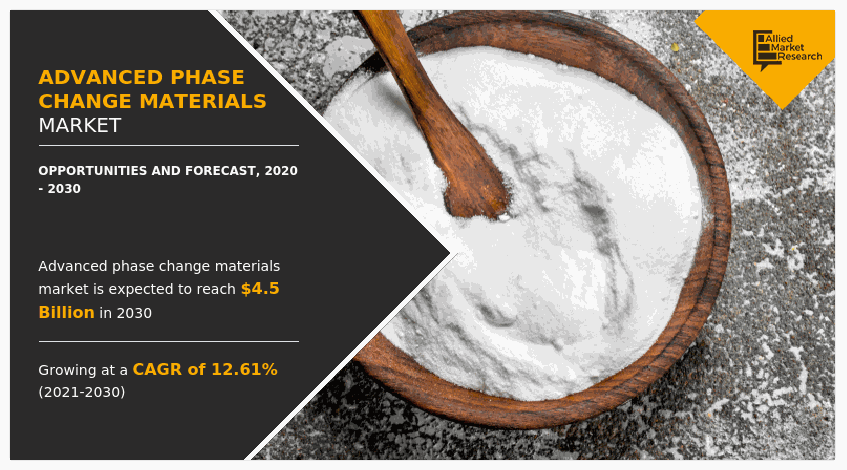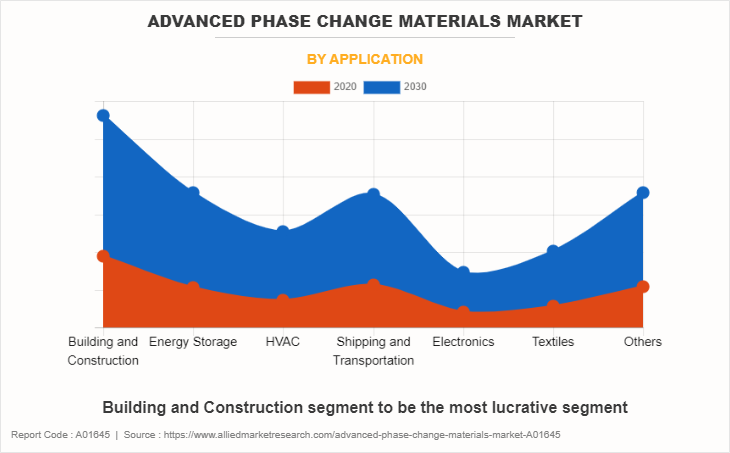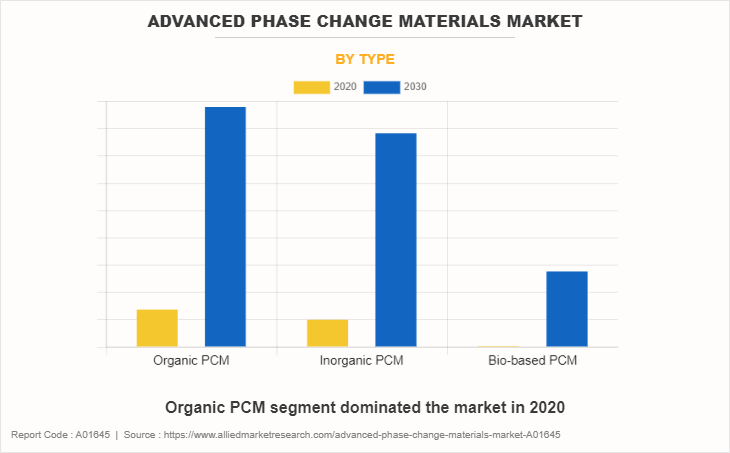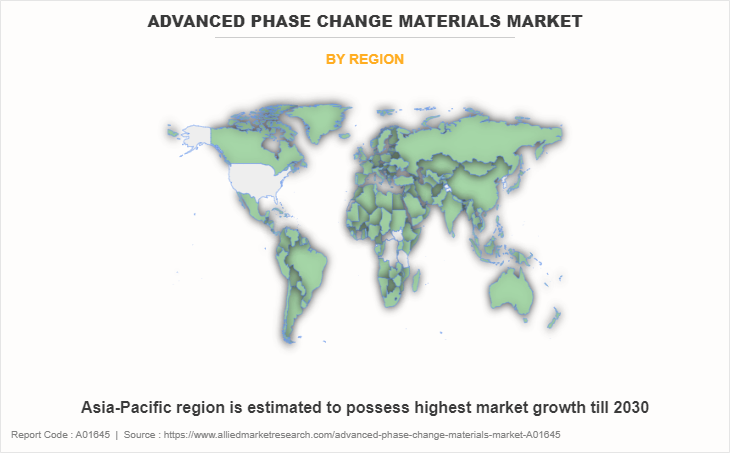The global advanced phase change materials market was valued at $1.4 billion in 2020, and is projected to reach $4.5 billion by 2030, growing at a CAGR of 12.61% from 2021 to 2030.
Advanced phase change materials are substances with high capacity to store and release large amounts of energy in the form of latent heat during phase change. Energy radiation is emitted when the physical state of the material changes at a constant temperature. The purpose is to utilize latent heat. In the event of an energy crisis, it is important to make effective use of existing energy supplies. The phase change material is also called latent heat storage.
In today's world, temperature-controlled packaging plays an important role in a variety of industries, such as food & beverages, pharmaceuticals, and biomedicine. Due to the rapid industrialization, the need for efficient refrigeration and transportation is increasing. The rise in demand for efficient temperature control materials drives demand for advanced phase change materials. Companies globally have adopted good distribution practice guidelines to verify their products and ensure that they are not exposed to harsh conditions that can affect quality in transit. Pharmaceuticals and biomedical products require some degree of temperature protection during transit.

Strict regulations for energy efficient construction and the surge in importance of energy conservation and sustainable development are expected to be key factors that drive the demand for advanced phase change materials during the forecast period. In addition, the growing demand for efficient insulation in commercial freezing and HVAC applications is estimated to increase the demand for advanced phase change materials. However, high product costs and relatively low awareness in developing markets are predicted to continue to limit market growth. Technological advances associated with the development of phase change materials and adoption of environmentally friendly solutions are expected to bring significant opportunities to the advanced phase change materials market.
The advanced phase change materials market is segmented on the basis of type, application, and region.
On the basis of type, it is categorized into organic PCM, inorganic PCM, and bio-based PCM. On the basis of application, it is segregated into building & construction, energy storage, HVAC, shipping & transportation, electronics, textiles, and others. By geography, the market is analyzed across North America, Europe, Asia-Pacific, and LAMEA. The Asia-Pacific region accounted for largest market share of the total revenue in 2020, followed by North America and Europe. The high adoption of phase change materials products in the region are expected to continue to bolster the advanced phase change materials market growth, due to presence of huge population base and presence of many developing countries in the region.
The key players operating in the global advanced phase change materials market are BASF SE, Entropy Solutions, Sonoco Products Company, Outlast Technologies LLC., Advansa B.V., E. I. Du Pont De Nemours and Company, Phase Change Energy Solutions, Cryopak Inc., Microtek Laboratories, Inc., and Pluss Advanced Technologies Pvt. Ltd. Other players in the value chain (not profiled in the report) include, Phase Change Materials Products Ltd., Rubitherm Technologies GmbH, Ciat Group, Datum Phase Change Ltd., Emco Klimatechnik Gmbh & Co. KG, Rgees LLC., Climator Sweden AB, Ewald Dörken AG, and Laird PLC., Companies operating in the global market compete for the share of the market through product launch, joint venture, partnership, and expanding the production capabilities to meet the future demand for the advanced phase change materials market during the forecast period.

The buildings & construction segment dominates the global advanced phase change materials market. Advanced phase change materials have a very important role to play in the construction industry, with the objective of saving energy and ensuring a clean and green future. With the advent of stringent regulations for energy efficient construction, particularly in the developed regions, has led to increase in demand for highly efficient and advanced thermal insulation materials. Also, the increase in emphasis towards green construction and rise in focus on energy conservation have amplified the demand for highly efficient and innovative construction materials owing to which, advanced phase change materials are being used in several applications, such as under floor electric heating system, phase change materials (PCM) filled glass windows, thermal efficient concrete, and other areas.

The bio-based segment is expected to possess highest market growth till 2030. Bio-based PCMs are a green alternative, such as fatty acid esters and fatty acids. Bio-based PCMs are materials derived from renewable and environment-friendly resources, from the agro-food sector production and its by-products, including food-grade materials, such as palm kernel oil, palm oil, coconut oil, and soybean oil. It is becoming more and more important for improving sustainability, minimizing environmental impact, and reducing carbon footprint in all sectors, as commercial materials used in most of the manufacturing industries are environment-friendly.
Organic PCMs are currently the most popular group of phase change materials and are often referred to as paraffin and non-paraffin. Non-paraffins are mostly derived from food-grade materials (vegetable oil) and are environment-friendly. However, considering the ever-growing global population, which increases the ever-growing food demand, in conjunction with the 2nd goal for sustainable development of the 2030 agenda adopted by all United Nations member state in 2015, there is need to focus attention on waste materials, such as food wastes, byproducts from agro-based food industries, and non-edible components of food crops, as potential bio-based PCMs substitute.

Asia-Pacific segment is expected to possess highest market growth till 2030 consisting of countries, such as China, India, Japan, South Korea, and rest of Asia-Pacific. Growth of textile and manufacturing sectors driven by substantial rise in personal income level coupled with improved monetary condition is the key factor that supports the market growth during the forecast spell. Countries such as China and India have begun to use PCMs in packaging, shipping applications, and transportation. China generates the most important profits related to PCM, which is expected to increase during the forecast period, thus driving market growth in the region. In China, phase change materials are used in different application sectors, including electronics, construction, packaging, and other industries. The Chinese government implemented several initiatives that focus on green development and rapid urbanization in the country. Advanced phase change materials are used in the development of green buildings owing to their unique properties. Hence, the PCM market holds immense potential for growth in the region during the forecast period.
COVID-19 Impact Analysis:
COVID-19 has severely impacted the global economy with devastating effects on global trade, which has simultaneously affected households, business, financial institution, industrial establishments, and infrastructure companies. Restrictions on international trade and lockdown regulations on the operations of the chemicals industry are projected to limit short-term demand for advanced phase change materials in the infrastructure market. Industries, manufacturing units, infrastructural projects, and mining operations were closed for the past two years due to the pandemic situation. The fluctuation in price of raw materials used to make phase change material and the COVID-19 pandemic hinder the growth of the phase change material market. Countries such as China, the U.S., and others are back on their feet, due to the availability of COVID-19 vaccines, and are continuing regular work due to the presence of huge investment in the infrastructure developments such as smart city, airports, and others.
Key Benefits For Stakeholders
- This report provides a quantitative analysis of the market segments, current trends, estimations, and dynamics of the advanced phase change materials market analysis from 2020 to 2030 to identify the prevailing advanced phase change materials market opportunities.
- The market research is offered along with information related to key drivers, restraints, and opportunities.
- Porter's five forces analysis highlights the potency of buyers and suppliers to enable stakeholders make profit-oriented business decisions and strengthen their supplier-buyer network.
- In-depth analysis of the advanced phase change materials market segmentation assists to determine the prevailing market opportunities.
- Major countries in each region are mapped according to their revenue contribution to the global market.
- Market player positioning facilitates benchmarking and provides a clear understanding of the present position of the market players.
- The report includes the analysis of the regional as well as global advanced phase change materials market trends, key players, market segments, application areas, and market growth strategies.
Advanced Phase Change Materials Market Report Highlights
| Aspects | Details |
| Market Size By 2030 | USD 4.5 billion |
| Growth Rate | CAGR of 12.6% |
| Forecast period | 2020 - 2030 |
| Report Pages | 226 |
| By Application |
|
| By Type |
|
| By Region |
|
| Key Market Players | Microtek Laboratories, Inc., Cryopak Inc., Sonoco Products Company, Advansa B.V., Phase Change Energy Solutions, Pluss Advanced Technologies Pvt. Ltd., BASF SE, Entropy Solutions, DuPont, Outlast Technologies LLC |
Analyst Review
The increase in use of microencapsulation and its technology in the construction and textile industries is gaining momentum in the global advanced phase change materials market. Many manufacturers use microencapsulated phase change materials (MEPCMs) because of the increase in surface area and improved heat transfer between the PCM and the environment. Another important trend in the market is the gradual shift of manufacturers to biodegradable bio-based PCM as an alternative to traditional petroleum-based PCM.
PCM applications includes, thermal energy storage, cold energy storage, waste heat recovery, heat pump systems, solar power plants, automotive thermal comfort, spacecraft thermal systems, electronic equipment thermal protection, fiber cooling, and computer cooling. In addition to this, it is also used in the production of products related to refrigeration systems, tropical telecommunications shelters, and medical applications, such as hyperthermia, blood transport, and treatment of obstetric asthma.
The global advanced phase change material market is undergoing various R&D initiatives leading to the introduction of multiple technologies, such as microencapsulation and molecular encapsulation. These technologies facilitate better integration of PCM into final products. In addition, phase change materials include apparel, jackets, tableware, hot plates, thermal seat cushions, medical wraps, hood warmers, tea coasters, cooling lithium-ion batteries, solar heating applications, automotive seat covers, cold chain transport, and dining mats. It has applications in helmet liners, and all cooling and heating applications where leaks need to be avoided. Therefore, with the introduction of new products, companies can expand the market for advanced PCM and enter new products.
The Asia-Pacific advanced phase-changing material market witnesses increase in the construction activity, rapid industrialization, and increase in awareness of phase change materials, especially in China, Japan, and South Korea. Rise in demand for biodegradable materials and strict enforcement of environmental regulations are expected to drive the growth of the bio-based PCM segment in the global market during the forecast period.
Use of Microencapsulated PCM in Textile Sector and Continued Technology Deveoplment in the field of Advanced PCM are the key factors boosting the Advanced Phase Change Materials Market growth
The market value of Advanced Phase Change Materials in 2030 is expected to be US$4.5 Billion
BASF SE, Entropy Solutions, Sonoco Products Company, Outlast Technologies LLC., Advansa B.V., E. I. Du Pont De Nemours and Company, Phase Change Energy Solutions, Cryopak Inc., Microtek Laboratories, Inc., and Pluss Advanced Technologies Pvt. Ltd.
Building and construction industry is projected to increase the demand for Advanced Phase Change Materials Market
The advanced phase change materials market is segmented on the basis of type, application, and region. On the basis of type, it is categorized into organic PCM, inorganic PCM, and bio-based PCM. On the basis of application, it is segregated into building & construction, energy storage, HVAC, shipping & transportation, electronics, textiles, and others. By geography, the market is analyzed across North America, Europe, Asia-Pacific, and LAMEA.
Need for Energy Conservation in Sectors Dependent on Non-Renewable Fossil-Based Resources is the Main Driver of Advanced Phase Change Materials Market
Building & construction, shipping and transportation end-use industry are expected to drive the adoption of Advanced Phase Change Materials
The fluctuation in price of raw materials used to make phase change material and the COVID-19 pandemic hinder the growth of the phase change material market. Countries such as China, the U.S., and others are back on their feet, due to the availability of COVID-19 vaccines, and are continuing regular work due to the presence of huge investment in the infrastructure developments such as smart city, airports, and others.
Loading Table Of Content...
Loading Research Methodology...


